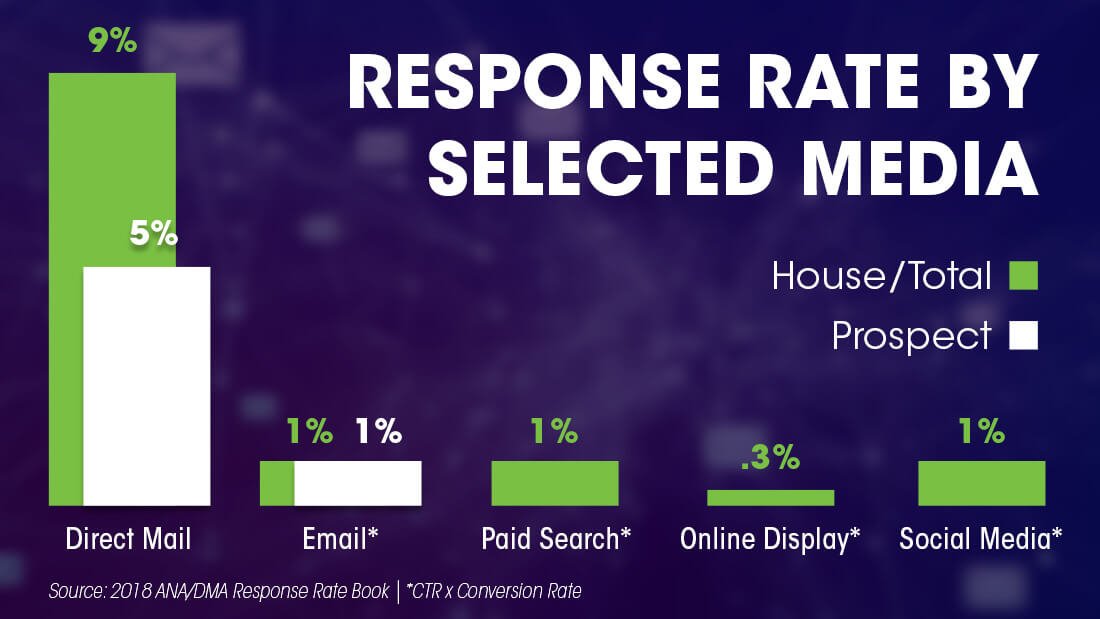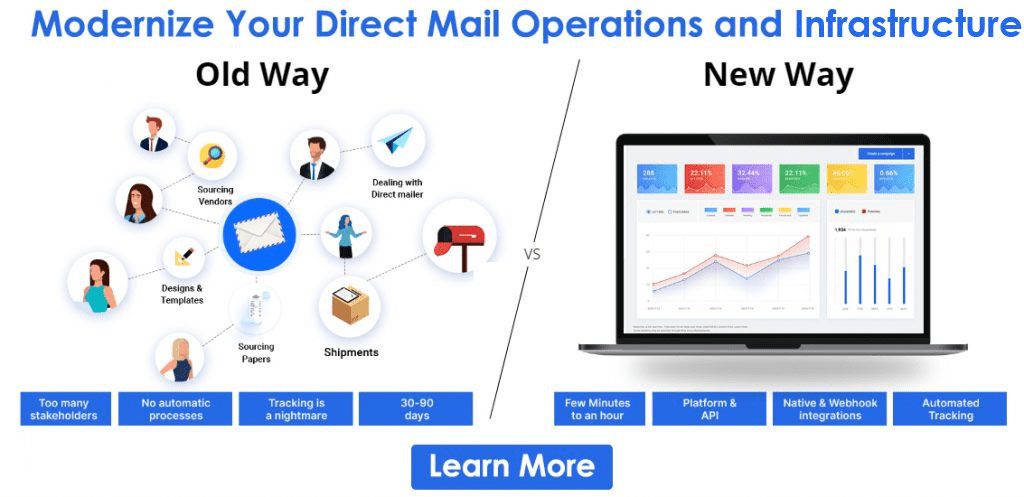Direct mail response rate
What Direct Mail Response Rates Should You Expect From Direct Mail Campaigns?
Direct Mail Marketing is used by almost every type of business nowadays. It helps make announcements, such as opening a new shop or giving a discount on a service or product, or providing any other necessary information. Direct marketing companies can target small to large audiences, and each campaign offers a different rate of returns as it depends on multiple marketing factors.

Whatever the industry or budget is, direct mail can help you reach as many people as possible, increase sales, create brand recognition, launch new products, and other similar benefits. It’s an effective campaign in itself, yet you can add more strategies to it if needed.
What Is A Good Response Rate For Direct Mail?
Direct mail response rates are an estimation of how many customers responded to your marketing campaign. Additionally, a high subjective value can accurately determine a high response rate.
In general, the average return rate on a direct mail campaign is about 0.5 to 2 percent, so if we assume that a campaign has 100 mails pieces, it means that out of them, 2 to 4 people respond, and only half of this number takes action. These numbers increase when you get maximum exposure to your brand, and you target only the specific audience, which can be your potential leads. When you create particular objectives with a compelling call to action like coupons, offers, or discounts, direct mail response rates also increase.
Good direct mail service acquisition response rates vary according to each business, and its sales and marketing goals. The average response rate for some marketers is around 2%, but for others, even 1% is also acceptable, and it’s realistic for them. If possible, the company’s old direct mails response rate should be used as a benchmark, which is useful for performance analysis.
Direct mail campaigns may result in a high response rate. Your marketing campaign’s success depends on the goals and purpose you set.
Here are some differences between direct mail campaigns focused on sales and those that focus on generating leads for you to better understand the concept:
- Your direct mail campaign should be highly informative if your company offers real estate solutions. Also, ensure that the campaign highlights the benefits of choosing you for your customers and offers a sign-up form so that they can receive more information. If the campaign is aimed at generating leads by providing relevant information, a high response rate in direct mail marketing would be valuable.
- As a financial services provider, you may find that many of your customers are not prepared to take advantage of the specific services you are offering. Here, it is worth noticing that a few loyal customers may increase profit, despite a low response rate to direct mail.
However, if you automate your direct mail campaign by using PostGrid, you can trigger your direct mail campaign to generate leads and sales- all at once, regardless of your industry.

What is the Average Direct Mail Response Rate?
Several companies are trying their luck through digital transformation- direct mail marketing is far from getting old. It is because when compared to email, direct mail has a higher response rate of 4.4%.
Furthermore, direct mail acquisition response rates are anywhere from 10 to 35 times higher than a traditional digital email campaign. 60 percent of customers say that receiving direct mail leaves a long-lasting impression in their everyday lives and helps them recall advertising later on. According to a recent study on direct mail:
- It has been found that direct mail marketing drives five times more sales than email marketing.
- Customers tend to appreciate direct mail since it stands out and creates a unique experience for them.
- Direct mail is a very shareable method as it is likely to be noticed by the entire household. The average lifespan of direct mail is 17 to 20 days.
Even though direct mail marketing can have a response rate of around 4.4%, it is meant to have a lasting impact that should be taken into account when evaluating your campaign. Also, according to recent statistics related to direct mail marketing around 42.2% of recipients either scan or read their direct mail.
However, you may not be gaining your direct mail response rates, but you are earning some undeniable and valuable impressions with your customers.
Let's take a look at some of the direct mail cases with astonishing statistics.

(image source: spectrummarketing.com)
The direct mail industry gets a higher response rate
We know that a high percentage of people like to get direct mail to sort and see quickly. But do they respond? According to the DMA response rate report, 5% of householders and an unknown percentage of business holders respond. According to a recent report, 4 % of B2B receivers also respond. Direct mail has a 9% average response rate for house lists and 4.9% for prospect lists in 2018, the Data & Marketing Association found compared to Less than 1% for Email, Paid Search, Online Display, and Social Media.
After comparison, the average direct mail response rate of well-known online channels was low. The email response rate is around 0.1%, the response rate of paid search is 0.6%, the social media response rate is 4%, and online display marketing has a response rate of 0.2%.
People can quickly sort through their mail
This is a very good way when you can get your mail back or retrieve it whether you are at home or anywhere else. If you are at home, you would have to go somewhere. If you are above the apartment, you have to come down. Have you ever tucked your mails into such occasions and enjoyed some of your other work? If so, then you are probably in the minority.
According to USPS’s report, about 80% of people pull mails and sort them in their mailboxes. People have a curiosity to know what is in the mail. And if the package they receive is big, they’re usually found eager to check what’s inside and who sent it to them. A high percentage of people check their mailboxes throughout the day. Like direct mail, no other channel provides the feature to notice your message so soon.
ROI from Direct mail is high
Apart from getting the response after applying all the Direct Mail Marketing Efforts, you would be interested in the audiences turning into paying customers. You may also want the recipients to take advantage of your given offers or discounts in the mailer. But what ROI should you expect? According to the DMA report, the average direct mail response rate for ROI from direct mail is about 30%.
 Also Read: Tips to Maximize Direct Mail ROI
Also Read: Tips to Maximize Direct Mail ROIWe know that online display marketing is cheap, but if you spend more than that on direct mail, you may get more direct mail returns than banner ads. As a professional marketer, you would want to create a strategy that combines both online marketing and offline marketing. If we talk about online marketing, direct mail marketing is such a method from which you can reap the benefits you cannot take from other methods like email, paid search, SEO, display marketing, social media, and many more.
Direct mail is not annoying like the Internet
It’s a fact that most of the time when we search online for any information, there is a barrage of ads all over the page, which is visible everywhere. Some of these are pop-up ads that ask for an email address. Some commercial videos are also seen, which we don’t care about. When we’re reading something, ads distract us. Thus, a quarter of internet users use ad blockers because it is irritating for some people.
It is also the main reason people give direct mail automation more value because it is not annoying like ads on the Internet.
According to the report of about a decade, prints have taken the most advantage of high ROI and more conversion rates. According to Printsbig.com, ads on the Internet are 55% more annoying than printed ones. The USPS reports have also stated that people usually like to find fascinating catalogs, postcards, or thank-you notes in their mailboxes.
Direct mail is an industry of about $50 billion
According to the DMA report, the value of the direct mail industry is about $45 billion. It’s the second-largest channel in the advertising industry. It grows at a higher rate every year. DMA confirms that if $14 is spent on direct mail, then the sale of products or services is about $2095.
According to this, a 1300% return has been received from direct mail, which proves to be a pretty good ROI.
However, ROI depends on how much you’re spending on your design and your mail copy of direct mail. It also depends on whether you’ve purchased any list or printing cost, mailing cost, or others. It also depends on the size, copy, and quantity of direct mail that you deliver. However, whatever the factors are, direct mail provides a high return on investment.
Nonprofits receive more donations from direct mail.
Consider if you get an email from a nonprofit organization. They ask you for donations for homeless and ill people. So you may open the email once, but you will definitely think, “why should I help them? I have no clue if it’s even legit.”
To get success, the nonprofit organization needs to provide fund security. The donor also needs to believe in the cause; only then she/he might think to donate. That’s where direct mail plays a vital role in nonprofit organizations. About 58% of people rely more on print marketing than other channels. According to USPS reports, those nonprofits using direct mail are getting 40% more donation impressions. Direct mail has proved to be an effective way for nonprofits.
Best Practices to Increase Direct Mail Response Rates
Work on the list
The most valuable asset that can increase the response rate is the list. I hope you have maintained an accurate one. If yes, you can see all your customer’s details and find what you can offer to attract them. The best way to target the right offer to the right people is to play with variable data in your mail pieces. It will create unique mail pieces not only from variable proposals but also from similar images.
Give Offers
More people respond when you give relevant offers on your services or products—increasing the direct mail acquisition response rate. If your campaign’s average direct mail response rate is low, you need to test what offers you’re making to which segment of your targeted audience. You would also need to check all wordings and avoid sending long or confusing proposals. Plus, check if you’re giving the appropriate incentives. Your offer should be relevant and concise to the specific audience. To test, add more new offers in your next campaigns and compare the response rate.
Custom Creative
An interesting thing to note is that your potential customers decide to read or leave before reading any mail piece based on the creative design. So, whatever cover you choose, keep in mind that it should deliver the message before anyone can read the entire mail piece and grab the reader’s attention. A wrong picture can affect the response rate. Sometimes changing the postcard to the letter in the envelope also increases the response. You should test with different formats so that you can choose the right design and also increase the response rate.
These are some essential factors that can increase your direct mail acquisition response rates. Sometimes the timing also matters. But you cannot always control everything. So pay attention to how you can manage and make a good direct mail piece for your customers and prospects.

Measuring the Targeted Direct Mail Response Rates
You may also consider calculating your response quality — how many of your response rates made a purchase.
The effectiveness of your campaign may be measured beyond your response rate and your ROI. Your response quality can be evaluated along with your sales rate. If not, then you set up methods to track sales or leads during a direct mail campaign such as contact numbers, coupons, offers, or personalized URLs.
Our professionals at PostGrid strongly recommend you to first try considering the key performance indicators used to track the performance of the same.
You may also consider the following options for measuring your targeted direct mail response rates:
- You can calculate your conversion rate by looking at the total % of customers who opted to order your products and services.
- Calculate the cost of every new lead, sales, order, and more with direct mail acquisition response rates. You can use this technique to compare your cost per acquisition from one campaign to another to determine whether another marketing strategy is more effective for boosting your ROI.
- It is also possible to calculate the average number of purchases and sales made by your direct mail campaign, as well as the revenue generated.
- Finally. You can estimate the cost of customer retention by calculating the customer lifetime value.
Several aspects of the direct mail campaign must be evaluated to determine its true value, and one of them is the response rate. It is important to consider your response rate in conjunction with other factors and growth indicators to fully comprehend the value of your campaign.
Conclusion
Regardless of how far you are diving in your direct mail marketing campaign, PostGrid is here to help you customize and work out throughout the same.
From uploading your mailing list to print, mailing, and tracking every piece of your direct mail campaign, we can help you launch a successful campaign targeting specific demographics.
Even if you are still in the designing phase, or you hold experience with a direct mail campaign, PostGrid helps you with everything and boosts your ROI.

Ready to Get Started?
Start transforming and automating your offline communications with PostGrid
The post Direct mail response rate appeared first on PostGrid.
source https://www.postgrid.com/direct-mail-response-rate/




Comments
Post a Comment